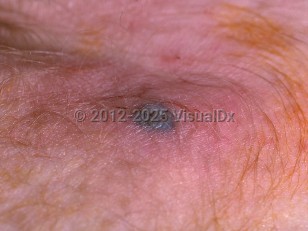- It is essential that sepsis and septic shock be recognized and treated as quickly as possible to help limit morbidity and mortality. Sepsis and septic shock should be suspected in any ill-appearing child with a temperature abnormality (below 36°C [96.8°F] or above 38°C [100.4°F]), tachycardia, tachypnea, and/or hypotension, or sepsis-related end-organ dysfunction.
- Rapid assessment of airway, breathing, and circulation (ABCs) should be initiated.
- Two large-bore intravenous (IV) lines should be placed, and fluid resuscitation with a rapid administration of 20 cc/kg of lactated Ringer's solution (but do not use with suspected metabolic conditions) or normal saline should be initiated if hypotension is present (or if sepsis and sepsis-associated end-organ dysfunction without hypotension is present and mechanical ventilation is available). An IV fluid bolus is not recommended in patients without hypotension if access to mechanical ventilation is not available.
- An intraosseous line may be needed in critically ill patients if an IV line cannot be established.
- Laboratory tests should be drawn, including a CBC with differential, blood culture(s), comprehensive metabolic panel (CMP), venous blood gas (VBG), lactate, urinalysis, and urine culture. A viral respiratory polymerase chain reaction (PCR) panel should be obtained where available. A point-of-care blood glucose test should be obtained.
- In stable patients with suspected central nervous system (CNS) involvement, a lumbar puncture should be performed with cerebrospinal fluid (CSF) analysis, PCR, and cultures sent.
- In cases of severe sepsis coagulation studies, fibrin and split products as well as cortisol should be checked.
- Administration of empiric broad-spectrum antibiotics should be initiated, ideally within 1 hour of arrival in the emergency department (ED) for septic shock and within 3 hours for sepsis without shock. Antibiotics should not be delayed while obtaining laboratory results, but it is best to get at least a blood culture before antibiotic administration, if possible.
- Different institutions have preferred antibiotic combinations based on local resistance patterns.
- In a nonmedically complex immunocompetent child without a central line, a common antibiotic combination used is ceftriaxone (50-100 mg/kg IV or intramuscularly [IM], maximum 2 g) with vancomycin (20 mg/kg/dose IV, maximum 2 g).
- Metronidazole (50 mg/kg/dose, maximum 2 g) may be added if intra-abdominal sources are suspected.
- If there is a severe allergy to ceftriaxone, aztreonam (40 mg/kg/dose, maximum 2 g) may be used.
- Fluid boluses are repeated in rapid succession until there is a clinical response (ie, hypotension / tachycardia improvement) for a total of 40-60 mL/kg, carefully watching for signs of fluid overload. If hypotension persists, pressor support with an epinephrine or norepinephrine drip should begin.
- Supplemental oxygen may be needed, as well as airway and breathing support ranging from nasal cannula to intubation with mechanical ventilation.
- Vitals should be monitored very closely, preferably by continuous monitoring.
- If hypoglycemia is present, it should be corrected.
Pediatric bacterial sepsis is a leading killer of children, outpacing deaths from childhood cancer. The hallmark of sepsis includes an abnormal temperature, leukocyte count, tachypnea, and tachycardia. Skin lesions, which can give a clue as to the cause of sepsis, result from direct vascular invasion and occlusion, vasculitis due to immune complex deposition, or the effect of toxins.
Bacterial sepsis in children is usually due to meningococcemia or gram-positive bacteria. Patients who are immunocompromised or have burns, neutropenia, or IV catheters are at higher risk for sepsis. Note: Neonatal sepsis is covered separately, as are many of the individual bacterial and fungal causes of sepsis. See also gonococcemia, Candida sepsis, Trichosporon beigelii sepsis, and septicemic plague.
Meningococcal disease – Meningococcal disease is a rapidly progressive infection caused by Neisseria meningitides, a gram-negative diplococcus bacterium. Symptoms may begin with a nonspecific viral-like illness that rapidly evolves (within hours) into 1 of 2 main presentations: meningitis or septicemia. Most cases are acquired through exposure to asymptomatic carriers via respiratory droplets. Children aged younger than 5 years and teenagers aged 15-19 years are predominantly affected.
Toxic shock syndrome (TSS) – In children, TSS most commonly follows surgery or skin injuries, but at times it can present with no preceding risk factors.
- Staphylococcal TSS is caused by Staphylococcus aureus strains that can produce the TSS toxin-1 (TSST-1). It more commonly has the typical erythrodermic skin findings compared with streptococcal TSS.
- Streptococcal TSS is also caused by exotoxins that cause massive stimulation of T cells via a superantigen mechanism. Clinically, the most common presenting symptom is severe pain in an extremity with or without underlying soft tissue infection. However, in children, streptococcal TSS may present without an identifiable source of infection. It may also be associated with bacteremia, endocarditis, pneumonia, pleural effusion, and/or osteomyelitis. A prodrome of fever, diarrhea, and myalgias is often seen. The macular exanthem seen in staphylococcal TSS is much less commonly found in streptococcal TSS. Approximately 48-72 hours after the initial onset, shock and multiorgan failure follow. In this form of TSS, risk factors include varicella infection, bites, and lacerations.
- Streptococcus pneumoniae is a common cause of sepsis in young children and children with HIV infection, sickle cell disease, other causes of asplenia, or nephrotic syndrome.
- Sickle cell patients are also at increased risk of sepsis due to Salmonella spp.
- Pseudomonas aeruginosa sepsis will occasionally present with skin lesions (ecthyma gangrenosum), and neutropenia is a major risk factor for this pathogen.
- Listeria monocytogenes infection is well documented in neonates, HIV-infected patients, and patients with impaired cellular immunity. In these patients, pneumonia and meningitis dominate the picture, but purpuric skin lesions may occur.
- Patients with complement deficiencies (late phase components C5-C9), including those with nephrotic syndrome, are susceptible to N meningitidis.



